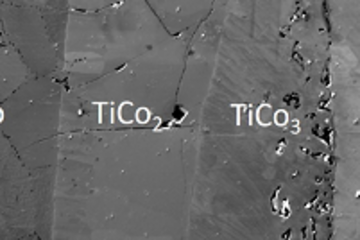All genres
281.
Journal Article
The Laplace project: An integrated suite for preparing and transferring atom probe samples under cryogenic and UHV conditions. PLoS One 13 (12), e0209211 (2018)
282.
Journal Article
Particle-induced damage in Fe–TiB2 high stiffness metal matrix composite steels. Materials and Design 160, pp. 557 - 571 (2018)
283.
Journal Article
Numerical Benchmark of Phase-Field Simulations with Elastic Strains: Precipitation in the Presence of Chemo-Mechanical Coupling. Computational Materials Science 155, pp. 541 - 553 (2018)
284.
Journal Article
Phase nucleation through confined spinodal fluctuations at crystal defects evidenced in Fe–Mn alloys. Nature Communications 9 (1), 1137 (2018)
285.
Journal Article
Beating hydrogen with its own weapons: nano-twin gradients enhance embrittlement resistance of a high-entropy alloy. Materials Today 21 (10), pp. 1003 - 1009 (2018)
286.
Journal Article
Elemental segregation to antiphase boundaries in a crept CoNi-based single crystal superalloy. Scripta Materialia 157, pp. 62 - 66 (2018)
287.
Journal Article
Cluster hardening in Al-3Mg triggered by small Cu additions. Acta Materialia 161, pp. 12 - 20 (2018)
288.
Journal Article
On the segregation of Re at dislocations in the γ'phase of Ni-based single crystal superalloys. Materialia 4, pp. 109 - 114 (2018)
289.
Journal Article
Bidirectional Transformation Enables Hierarchical Nanolaminate Dual‐Phase High‐Entropy Alloys. Advanced Materials 30 (44), 1804727 (2018)
290.
Journal Article
Atomic scale analysis of grain boundary deuteride growth front in Zircaloy-4. Scripta Materialia 156, pp. 42 - 46 (2018)
291.
Journal Article
On the nature of twin boundary-associated strengthening in Fe–Mn–C steel. Scripta Materialia 156, pp. 27 - 31 (2018)
292.
Journal Article
Compositional evolution of long-period stacking ordered structures in magnesium studied by atom probe tomography. Scripta Materialia 156, pp. 55 - 59 (2018)
293.
Journal Article
Enhanced strength and ductility in a high-entropy alloy via ordered oxygen complexes. Nature 563 (7732), pp. 546 - 550 (2018)
294.
Journal Article
Eliminating deformation incompatibility in composites by gradient nanolayer architectures. Scientific Reports 8 (1), 16216 (2018)
295.
Journal Article
Machine-learning-based atom probe crystallographic analysis. Ultramicroscopy 194, pp. 15 - 24 (2018)
296.
Journal Article
Combinatorial metallurgical synthesis and processing of high-entropy alloys. Journal of Materials Research 33 (19), pp. 3156 - 3169 (2018)
297.
Journal Article
Nano-laminated thin film metallic glass design for outstanding mechanical properties. Scripta Materialia 155, pp. 73 - 77 (2018)
298.
Journal Article
Formation of eta carbide in ferrous martensite by room temperature aging. Acta Materialia 158, pp. 297 - 312 (2018)
299.
Journal Article
Elemental segregation to twin boundaries in a MnAl ferromagnetic Heusler alloy. Scripta Materialia 155, pp. 144 - 148 (2018)
300.
Journal Article
On the role of the collinear dislocation interaction in deformation patterning and laminate formation in single crystal plasticity. Mechanics of Materials 125, pp. 70 - 79 (2018)











